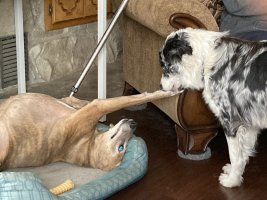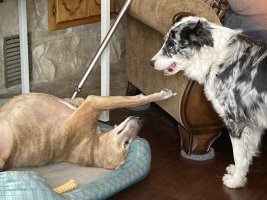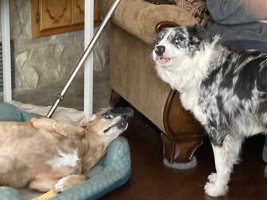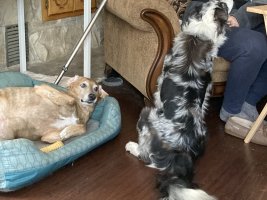Legamin
Loving the herd life
I have been building a herd of Leicester Longwool sheep and contrary to my original hopes of a small cottage farm with a ‘gentleman’s ranch’ type arrangement….my usual disregard for good judgement has expanded our farm into a multi flock breeding operation with most of my retirement out walking around on four hooves with wiggly little tails Looking like a well quaffed cotton ball with hay bits dangling from the corner of their maws.
The need for a guardian has begun to plague me at night as I try to sleep and hear the night song of hundreds of local coyote that come down from the hills and wander the edges of the surrounding farms looking for a hole in the fence or a gate left open. When I say ‘hundreds’ I don’t mean to exaggerate so what I really mean is that by the literal deafening noise of yipping when I step outside with my whistle, shotgun and high powered flood light I really mean that it could be THOUSANDS. We have heavily wooded forest mountains all surrounding the farm valley for miles in every direction. We are fairly isolated and because of the low traffic of people in the area they are not intimidated much at all. We have spent….well….a lot on welded steel fence panels around the entire perimeter of our 10 acres and added an electric perimeter, motion sensors and flood lights, motion sensor alarms and alert sensors that flash warnings and pictures of anything bigger than a house fly that makes it through any part of the outer perimeter. Inside the barns is video monitoring with alert warnings at the house. Two of the four barns are near the house but the other two are about four city blocks from the house and half mile respectively so it’s not easy to run out and check things in the middle of the night if a flash warning goes off.
But I digress….. I have mentioned this to neighbors and friends and found that everyone has a very strong opinion of the ‘very best’ guard animal for my sheep…most of them don’t have sheep…. The consensus is big fluffy dog as a a guardian animal. There are a lot of pluses to this method of protection as I know dogs, have always had dogs, love dogs and inherently trust dogs to be able to conduct themselves in an honest and upright manner if I get them as puppy and let them grow up in the sheep barn with the sheep. I get dogs. But many of my shepherd friends are telling me that the “ABSOLUTE ONLY WAY TO GO” is a guard Llama. Llamas I DONT know. I’ve never seen one outside a zoo or my neighbor’s front yard…(kind of the same thing)… A llama would be a whole different breed, a different size of animal, different health needs, require a different shearer for JUST ONE animal….I am hesitant to add a new level of complication to my already busy life. A perfect stranger to me who overheard a conversation chimed in and insisted that a DONKEY/Mule would be the answer to my prayers. AND…if I didn’t Mind taking a bit longer doing my work I could use them to plow the fields, harvest the hay…oh what a conversation we had that seemed a lot like taking a time machine back to 1820 and working 20 hours per day just for the privilege of having a guard animal for my flock.
Of course the temptation is to just continue adding technological doo dads and bits and bobs interspersed with whistling whirlygigs along the perimeter to electrocute, startle, blast with siren and photograph for posterity every movement of every beast and insect that dares to perpetrate a criminal action within 25 cm of any part of the outer fence. Of course there are the recommended flood lights and drones with alarms and national headline alerts, intersecting radio towers and call signs for every sheep to check in at least every hour on the hour….”Technology is your FRIEND!” So the salesman on my front porch insisted earnestly as he hovered his drone over the rose beds.
I am still not settled. Any animal means more work, more infrastructure, more poop, more maintenance and more vet bills. Technology, on the other hand, means endless upgrades, software contracts, low voltage wiring electricians, hardware to carry hanging from my already much stressed suspenders and something called “firmware upgrades and security management” that sounds suspiciously like my new tractor starting itself and driving into the lake before I even get to drive it home from the dealership next year…there seems to be something that needs to be done urgently every other week and equipment upgrades annually and maintenance contracts with on site ‘tech teams’ that will all tape hundreds of hours of video every day that I can watch in all my spare time after 12-18 hours of hard work among the wooly and the unwashed. Choices, choices, choices. I leaned heavily towards ‘dog’…it just seems so natural….but I already have two. One is a hound that never learned to hunt except in her dreams where she howls, runs, barks, yips and farts mostly all at the same time and for about a half hour every night. She went hunting with me once and got lost for two days…I didn’t want to hunt that year anyways. The other is (according to the breeder) a “VERY special dog!” She is a beautiful Border Collie, the most obedient dog I have ever owned, evidently plated in 24 Carrot Gold on the inside if I try to justify the price and she only has one fault that I didn’t find out until I took her from the training field into the pasture to work….she is TERRIFIED of SHEEP! She seems to want to get close to the sheep but not to herd them or move them in any way but rather she clearly wants companionship from them! She is literally trying to be part of the herd! The clear problem, as far as the sheep are concerned, is that she is not a sheep and seems to make them very nervous when she walks up an tries to do sheep things and gain their acceptance. She is clearly flabbergasted that the ewes have the temerity to stamp their feet at her and charge her until she runs away! ’Soda’ (yep…that‘s the name she came with…REALLY!) sulks back to the house three feet behind me utterly silent and absolutely dejected that her new hoped for relationship with ‘the big fluffy dogs’ not only failed but backfired with disasterously dangerous consequences. Everyday we practice the commands and she runs her routine flawlessly… Everyday we go out to the pasture and she trots up and tries to make nice with the sheep and they stamp several times before charging at her and chasing her out of the pasture. Everyday…..she reminds me EVERYDAY that thirty five hundred dollars is now costing me a bowl of dog food twice per day and nuzzling me every time she wants another crack at her love/hate relationship with the ’big fluffy dogs’…she is the smartest most obedient stupid dog I have ever owned and she serves no purpose. None.
So if you are still reading and you have a suggestion as to the ‘BEST’ flock guardian for a mid sized herd. I’m willing to listen…but the wallet stays closed until I’m REALLY convinced!
thanks all, I know you will give your best advice!
The need for a guardian has begun to plague me at night as I try to sleep and hear the night song of hundreds of local coyote that come down from the hills and wander the edges of the surrounding farms looking for a hole in the fence or a gate left open. When I say ‘hundreds’ I don’t mean to exaggerate so what I really mean is that by the literal deafening noise of yipping when I step outside with my whistle, shotgun and high powered flood light I really mean that it could be THOUSANDS. We have heavily wooded forest mountains all surrounding the farm valley for miles in every direction. We are fairly isolated and because of the low traffic of people in the area they are not intimidated much at all. We have spent….well….a lot on welded steel fence panels around the entire perimeter of our 10 acres and added an electric perimeter, motion sensors and flood lights, motion sensor alarms and alert sensors that flash warnings and pictures of anything bigger than a house fly that makes it through any part of the outer perimeter. Inside the barns is video monitoring with alert warnings at the house. Two of the four barns are near the house but the other two are about four city blocks from the house and half mile respectively so it’s not easy to run out and check things in the middle of the night if a flash warning goes off.
But I digress….. I have mentioned this to neighbors and friends and found that everyone has a very strong opinion of the ‘very best’ guard animal for my sheep…most of them don’t have sheep…. The consensus is big fluffy dog as a a guardian animal. There are a lot of pluses to this method of protection as I know dogs, have always had dogs, love dogs and inherently trust dogs to be able to conduct themselves in an honest and upright manner if I get them as puppy and let them grow up in the sheep barn with the sheep. I get dogs. But many of my shepherd friends are telling me that the “ABSOLUTE ONLY WAY TO GO” is a guard Llama. Llamas I DONT know. I’ve never seen one outside a zoo or my neighbor’s front yard…(kind of the same thing)… A llama would be a whole different breed, a different size of animal, different health needs, require a different shearer for JUST ONE animal….I am hesitant to add a new level of complication to my already busy life. A perfect stranger to me who overheard a conversation chimed in and insisted that a DONKEY/Mule would be the answer to my prayers. AND…if I didn’t Mind taking a bit longer doing my work I could use them to plow the fields, harvest the hay…oh what a conversation we had that seemed a lot like taking a time machine back to 1820 and working 20 hours per day just for the privilege of having a guard animal for my flock.
Of course the temptation is to just continue adding technological doo dads and bits and bobs interspersed with whistling whirlygigs along the perimeter to electrocute, startle, blast with siren and photograph for posterity every movement of every beast and insect that dares to perpetrate a criminal action within 25 cm of any part of the outer fence. Of course there are the recommended flood lights and drones with alarms and national headline alerts, intersecting radio towers and call signs for every sheep to check in at least every hour on the hour….”Technology is your FRIEND!” So the salesman on my front porch insisted earnestly as he hovered his drone over the rose beds.
I am still not settled. Any animal means more work, more infrastructure, more poop, more maintenance and more vet bills. Technology, on the other hand, means endless upgrades, software contracts, low voltage wiring electricians, hardware to carry hanging from my already much stressed suspenders and something called “firmware upgrades and security management” that sounds suspiciously like my new tractor starting itself and driving into the lake before I even get to drive it home from the dealership next year…there seems to be something that needs to be done urgently every other week and equipment upgrades annually and maintenance contracts with on site ‘tech teams’ that will all tape hundreds of hours of video every day that I can watch in all my spare time after 12-18 hours of hard work among the wooly and the unwashed. Choices, choices, choices. I leaned heavily towards ‘dog’…it just seems so natural….but I already have two. One is a hound that never learned to hunt except in her dreams where she howls, runs, barks, yips and farts mostly all at the same time and for about a half hour every night. She went hunting with me once and got lost for two days…I didn’t want to hunt that year anyways. The other is (according to the breeder) a “VERY special dog!” She is a beautiful Border Collie, the most obedient dog I have ever owned, evidently plated in 24 Carrot Gold on the inside if I try to justify the price and she only has one fault that I didn’t find out until I took her from the training field into the pasture to work….she is TERRIFIED of SHEEP! She seems to want to get close to the sheep but not to herd them or move them in any way but rather she clearly wants companionship from them! She is literally trying to be part of the herd! The clear problem, as far as the sheep are concerned, is that she is not a sheep and seems to make them very nervous when she walks up an tries to do sheep things and gain their acceptance. She is clearly flabbergasted that the ewes have the temerity to stamp their feet at her and charge her until she runs away! ’Soda’ (yep…that‘s the name she came with…REALLY!) sulks back to the house three feet behind me utterly silent and absolutely dejected that her new hoped for relationship with ‘the big fluffy dogs’ not only failed but backfired with disasterously dangerous consequences. Everyday we practice the commands and she runs her routine flawlessly… Everyday we go out to the pasture and she trots up and tries to make nice with the sheep and they stamp several times before charging at her and chasing her out of the pasture. Everyday…..she reminds me EVERYDAY that thirty five hundred dollars is now costing me a bowl of dog food twice per day and nuzzling me every time she wants another crack at her love/hate relationship with the ’big fluffy dogs’…she is the smartest most obedient stupid dog I have ever owned and she serves no purpose. None.
So if you are still reading and you have a suggestion as to the ‘BEST’ flock guardian for a mid sized herd. I’m willing to listen…but the wallet stays closed until I’m REALLY convinced!
thanks all, I know you will give your best advice!







 How do I know? Because Carson, the big black Great Dane/Labrador cross came up on the porch and told me so. I can't keep him in. GP's roam. If their feet are on it, it is theirs. If they see it, it is theirs-and they want to go visit their kingdom. Trip can clear almost any fence. My female could squeeze through a hole that a rat could. Amazing how she could disjoint her whole body and escape through a hole that repelled water. But they are generally friendlier than Anatolians and not as stubborn.
How do I know? Because Carson, the big black Great Dane/Labrador cross came up on the porch and told me so. I can't keep him in. GP's roam. If their feet are on it, it is theirs. If they see it, it is theirs-and they want to go visit their kingdom. Trip can clear almost any fence. My female could squeeze through a hole that a rat could. Amazing how she could disjoint her whole body and escape through a hole that repelled water. But they are generally friendlier than Anatolians and not as stubborn.